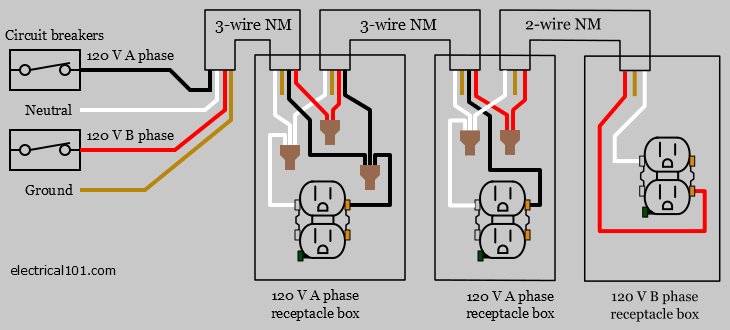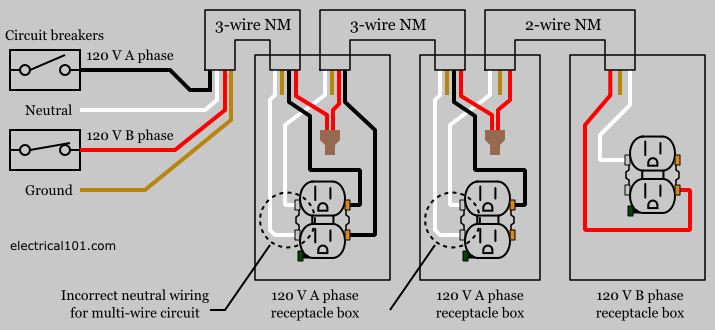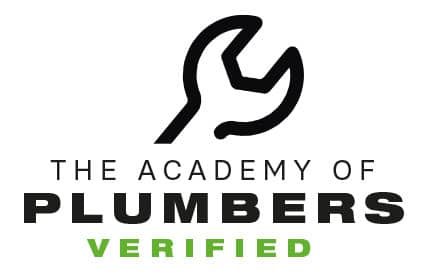According to NEC Article 100, a multiwire branch circuit consists of two or more ungrounded conductors that have a voltage between them, and a grounded conductor that has equal voltage between it and each ungrounded conductor of the circuit and that is connected to the neutral or grounded conductor of the system. (Basically, two hot wires are sharing a neutral wire.)
This circuit has also been referred to as:
- The Edison Circuit
- Common Neutral Circuit
- Shared Neutral Circuit
This Photo is an Example of a Multiwire Branch Circuit Preferred Wiring Diagram.
This Photo is an example of a Multiwire Branch Circuit Incorrect Wiring Diagram.
Why are multiwire branch circuits used?
Multiwire branch circuits can offer fewer conductors, reduce the raceway size and reduce voltage drop.
What are the possible electrical hazards?
Improper wiring or mishandling of multiwire circuits can cause overloading of the grounded (neutral) conductor and/or destruction of equipment.
Overloading Of The Grounded (Neutral) Conductor.
Failure to properly terminate the ungrounded (hot) conductors to separate phases could cause the grounded (neutral) conductor to become overloaded from excessive neutral current, and the insulation could be damaged or destroyed. Conductor overheating is known to decrease insulating material service life, potentially resulting in a fire from arcing faults in hidden locations. We do not know just how long conductor insulation will last, but heat does decrease its life span.
Destruction of Equipment.
Never remove the grounded (neutral) conductor from the grounded terminal bar in the panel board if the phase conductors are energized. The grounded (neutral) conductor you remove could be part of a multiwire branch circuit, so this could result in destruction of electrical equipment. More important, even if the return conductor is not part of a multiwire circuit, removing a conductor from the grounded terminal bar when the circuit is energized could result in injury due to shock or arcing.
What are the safety requirements according to NEC 2014?
Never remove the grounded (neutral) conductor from the grounded terminal bar in the panelboard if the phase conductors are energized — it could be part of a multiwire branch circuit, and removing it could ruin electrical equipment.
NEC Section 210.4(B) states that in the panel board where the branch circuit originates, all undergrounded conductors must be provided with a means to disconnect them simultaneously.
NEC Section 210.4(D) is that the undergrounded and grounded Edison circuit conductors are to be grouped by cable tires or similar means in at least on location within the panelboard. This ensures that the wires will be hooked up correctly, with the ungrounded conductors connected to opposite phases. An exception states that the requirement for grouping does not apply if the circuit enters from a cable or raceway unique to the circuit that makes the grouping obvious.
What to do when a common neutral hazard is discovered?
Stop work and remove the hazardous condition or plan a new work package considering known energized conductors. It should be corrected by the installation of pigtails or other means, to maintain continuity of the neutral wiring in accordance with NFPA 70 National Electrical Code and by licensed professional electricians.
(These circuits are typically found on 120 / 240-volt single-phase systems, but can be found on 208Y /120 and 277Y / 480 volt systems as well.)
Other general precautions include:
- Label the doors of lighting and power panels where common neutrals are known to exist. This will alert workers and electricians who are servicing your electrical equipment of potential problems.
- If you have an electrician servicing your electrical equipment, make sure you provide instructions in your work order where common neutrals exist.
- As an electrician, you can suspect a multi-wire branch circuit when three or more neutral conductors are spliced together in a junction box, outlet box, or lighting fixture.
There is nothing wrong with using multi-branch but if you do decide that it is the best option, then make sure you take proper precautions as per code, NEC 2014. Ensure that you have a licensed and professional electrician installing or servicing your home/facility’s electrical equipment.






